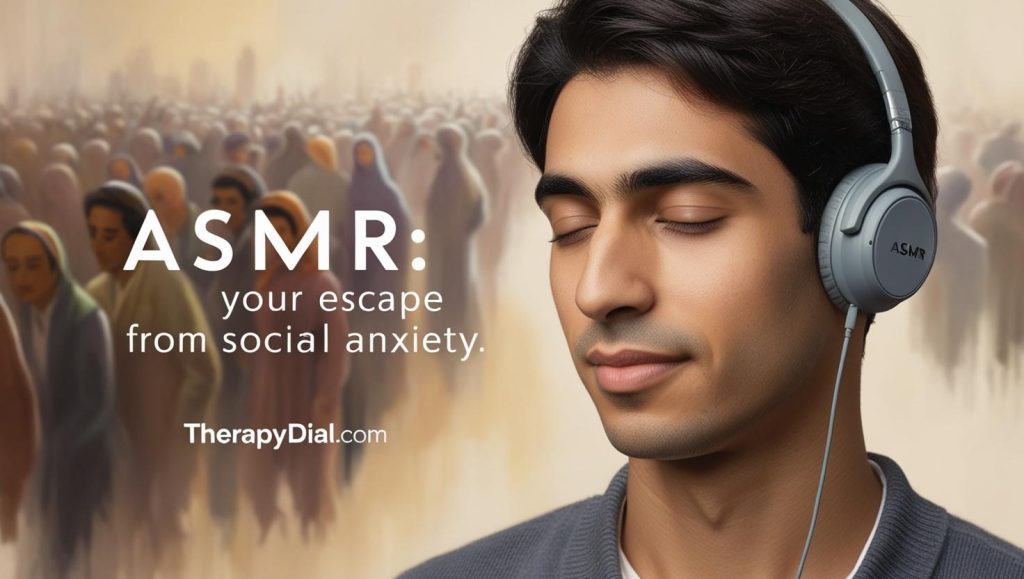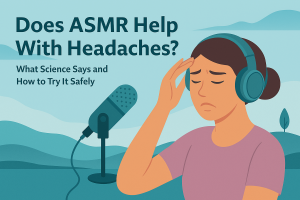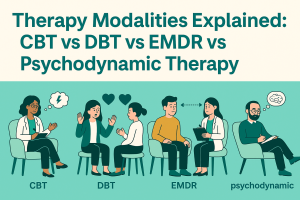Understanding Social Anxiety
You know that jittery feeling in your chest before speaking up in a group? Or the way your mind races when you’re walking into a crowded room? That’s social anxiety. It’s not just shyness—it’s an intense, often paralyzing fear of being judged, rejected, or embarrassed in social situations. And for millions of people around the world, it’s a daily reality.
Social anxiety can make even the most routine interactions feel daunting. Whether it’s ordering food, answering a phone call, or attending a meeting, these situations trigger an overwhelming fight-or-flight response.
Your heart races, your palms sweat, and your thoughts spiral into worst-case scenarios. Sleep suffers, self-esteem takes a hit, and relationships can feel impossible to maintain.
It’s no surprise that people with social anxiety are always looking for relief—something natural, non-invasive, and calming. That’s where ASMR steps in.
The Rise of ASMR as a Mental Health Tool
Autonomous Sensory Meridian Response, or ASMR, might have started as an internet curiosity, but it’s now a full-blown wellness tool. With millions of followers and thousands of dedicated YouTube channels, ASMR has grown into a supportive sanctuary for people struggling with everything from insomnia to—you guessed it—social anxiety.
At first glance, ASMR videos can seem quirky or even confusing. But beneath the soft whispers, tapping fingers, and soothing hand movements lies something powerful: a calming balm for overstimulated minds. People who experience ASMR report feelings of warmth, calmness, and emotional security—exactly what’s needed to dial down the anxiety dial.
In this article, we’re diving deep into how ASMR can specifically help with social anxiety. We’ll unpack the science, share real-life case studies, and give you practical tips to make ASMR part of your healing journey.
What is ASMR?
Origins and Evolution of ASMR

ASMR isn’t new, but the term only became mainstream in the last decade. Coined in 2010, “Autonomous Sensory Meridian Response” refers to that distinct tingling sensation people get when exposed to certain visual, auditory, or tactile stimuli. It usually starts at the scalp and moves down the spine, creating a euphoric sense of relaxation.
Before the acronym existed, people were already experiencing it—often during childhood. Maybe it was the way a teacher slowly turned the pages of a book or the gentle sound of someone brushing hair. These “brain tingles” weren’t easily explained but were undeniably soothing.
Thanks to platforms like YouTube, ASMR creators—or “ASMRtists”—began crafting videos specifically designed to trigger this sensation. What began with whispering and tapping has expanded into complex roleplays, nature soundscapes, and even virtual therapy sessions.
Common ASMR Triggers and How They Work
Everyone has different triggers, but some of the most popular include:
- Whispering: Gentle, breathy voices often combined with affirmations or storytelling.
- Tapping: Rhythmic finger tapping on various objects like glass, wood, or plastic.
- Personal attention: Roleplays that simulate direct interaction, such as spa treatments, haircuts, or doctor visits.
- Crinkling: Soft, textured sounds from paper, foil, or plastic.
- Nature sounds: Rainfall, ocean waves, and birdsong for immersive tranquility.

These triggers work by providing sensory input that engages your brain’s parasympathetic nervous system—essentially flipping the switch from “panic” to “peace.” It’s like tricking your brain into a safe space where it doesn’t need to be on high alert.
The Link Between ASMR and Anxiety Relief
How ASMR Affects the Brain and Nervous System
Here’s the science behind the sensation: ASMR stimulates areas of the brain associated with emotional arousal, bonding, and relaxation. Specifically, studies using fMRI scans show ASMR activates regions like the medial prefrontal cortex and nucleus accumbens—the same areas linked to dopamine release and calming sensations.
This isn’t just about tingles—it’s a neurological shift. ASMR triggers promote a drop in heart rate and cortisol levels, both of which are elevated during anxiety attacks. It encourages the body to breathe slower, muscles to relax, and thoughts to soften.
For people with social anxiety, whose nervous systems are in constant fight-or-flight mode, ASMR can act like a reset button. Instead of spiraling into anxious thoughts before a social event, you can put on a soothing video, refocus your attention, and give your brain a new script: “You’re okay. You’re safe.”
Key Scientific Findings on ASMR and Anxiety
Recent research backs up these claims. A 2018 study published in PLOS ONE found that people who watched ASMR videos experienced a significant reduction in heart rate and increased feelings of social connection and emotional well-being. Another study from PeerJ concluded that ASMR viewers reported lower levels of anxiety and depression overall.
The anecdotal evidence is just as powerful. Many individuals describe ASMR as a “lifeline” or “safe space”—a digital friend that calms them before work meetings, family gatherings, or even just walking into a crowded store.
And unlike medication, ASMR has zero side effects. It’s accessible, free, and can be tailored to your exact needs.
Case Study #1: Overcoming Public Speaking Fear
Background of the Subject
Meet Amanda, a 29-year-old graphic designer who dreaded one thing more than anything else: public speaking. Just the thought of standing in front of a group made her nauseous. Her hands would tremble, her voice would crack, and she’d often lose sleep the night before a presentation.
Amanda had tried everything—deep breathing, preparation scripts, even beta-blockers—but the fear never truly went away. One night, while scrolling on YouTube, she stumbled upon a video titled “You’re Going to Be Okay – ASMR for Anxiety” by Gibi ASMR. Curiosity piqued, she clicked.
What followed surprised her. As the ASMRtist whispered comforting words and simulated a therapy session, Amanda felt her heart rate slow down. She wasn’t alone in the dark. Someone was there, gently guiding her through the fear.
ASMR Routine and Results
Amanda began incorporating ASMR into her nightly routine, especially before presentations or meetings. Her go-to triggers? Soft whispering, guided affirmations, and personal attention roleplays like mock therapy sessions or encouragement videos.
After just a few weeks, she noticed a tangible difference:
- She could fall asleep more easily the night before speaking engagements.
- Her pre-event jitters became manageable with a 20-minute ASMR “calm down” session.
- She began feeling more confident—not just in her speaking abilities, but in her ability to cope.
Today, Amanda says ASMR didn’t erase her anxiety completely, but it gave her control. It became a reliable tool to ease her mind and prepare her body for social interaction—something that once felt impossible.
Case Study #2: Coping with Social Gatherings
The Subject’s Anxiety Triggers
Let’s talk about Jalen, a 34-year-old software engineer. On the surface, he was a high-functioning professional, but underneath, social events drained him. Office parties, weddings, networking mixers—even casual get-togethers—felt like battlefields. The worst part? Everyone else seemed to love them, which made him feel broken or “weird.”
Jalen’s social anxiety didn’t come from a lack of social skills; it came from overthinking. He’d replay conversations in his head, worry about being judged, and hyper-fixate on his body language. These events often led to panic attacks, headaches, or total emotional burnout.
Therapy helped him recognize the patterns, but something was still missing—he needed a daily method to decompress and calm his racing thoughts. That’s when he discovered ASMR.
ASMR Triggers That Helped
Jalen found himself especially drawn to:
- Personal attention roleplays where ASMRtists speak directly to the viewer
- Soft-spoken therapist sessions
- “Safe space” affirmations and grounding techniques
- Hand movement visuals, which helped slow his thoughts
Before any big event, Jalen would watch ASMR videos for 30 minutes. He called it his “social armor.” It gave him a chance to rehearse calm—like exposure therapy without leaving his couch. He began to attend more events, and even when the anxiety showed up, he could manage it without spiraling.
Now, ASMR is a part of Jalen’s everyday routine. He listens before work, during breaks, and especially before social situations. It helps him center himself, reclaim his energy, and feel socially “ready”—on his terms.
Case Study #3: Easing School-Related Social Stress
Teenage Perspective
Ellie, a 16-year-old high school student, struggled with lunch breaks more than exams. The hallways were loud, the cafeteria overwhelming, and group projects triggered full-blown anxiety attacks. Social interactions at school weren’t just awkward—they were terrifying.
Ellie’s anxiety also spilled over into sleep. She’d replay awkward moments over and over at night, sometimes crying herself to sleep. Her mom tried everything—therapy, breathing apps, even medication—but nothing seemed to help long-term. Then, one night, Ellie found a YouTube video titled “High School ASMR Roleplay – You’re Not Alone”.
She watched. Then she cried. Then she fell asleep for the first time in weeks without spiraling thoughts.
Role of Daily ASMR Consumption
Ellie started using ASMR videos every evening after school. Her favorite triggers were:
- Teen-friendly whisper roleplays like “first day of school” scenarios
- Encouraging, positive affirmations
- Light tapping combined with soothing words
She also began using ASMR audio in the morning before school to reduce anticipatory anxiety. It wasn’t a cure-all, but the difference was night and day. Her panic attacks decreased. Her grades improved. And most importantly—she started smiling again.
ASMR became a digital friend when real-world interaction felt too hard. It gave Ellie space to breathe, regroup, and find her calm in a world that often felt too loud.
Why ASMR is So Effective for Social Anxiety
Simulated Personal Attention
People with social anxiety often crave connection—but fear it at the same time. ASMR bridges that gap. Personal attention roleplays offer eye contact, affirming words, and gentle care without real-world risk. It’s social connection in its safest form.
When someone whispers “You’re doing great,” or “It’s okay to feel nervous,” the brain registers it as actual validation. Over time, this simulated interaction can help reshape internal narratives, replacing fear-based thinking with safety and self-compassion.
Calming the “Fight or Flight” Response
Social anxiety is rooted in the fear of rejection, which triggers your brain’s amygdala—the fear center. ASMR hijacks that response, turning down the volume on your panic signals. You breathe slower, your muscles loosen, and your mind softens. That’s the magic.
Unlike traditional coping strategies that require effort, ASMR asks only that you press play and listen. It’s passive, but powerful—a reset button for overwhelmed minds.
The Most Effective ASMR Triggers for Social Anxiety
Whispering and Affirmations
This combo works wonders. Soft-spoken affirmations like “You are safe,” “I’m proud of you,” or “It’s okay to be nervous” can feel incredibly grounding. Repetition and tone matter—so the slower, the better.
Personal Roleplays (Therapist, Friend, etc.)
Therapist roleplays mimic a comforting session where you’re being validated and encouraged. Friend roleplays feel like heart-to-hearts on bad days. These videos model emotional safety, helping rewire social fears from the ground up.
Nature Sounds and Background Ambience
Sometimes, simplicity is key. Rain, ocean waves, or forest ambience can act like auditory blankets—especially helpful when words feel overwhelming. They allow you to self-soothe in silence.

Creating a Personalized ASMR Toolkit
How to Choose the Right Triggers
Explore different categories:
- If you’re highly auditory: Try whispering, tapping, or slow speaking.
- If you’re visual: Hand movements, roleplay, or face tracing might work better.
- If overstimulation is an issue: Stick with minimalist nature sounds.
Keep a journal to track which videos reduce anxiety best. Rate how you feel before and after each session—it’ll help you narrow down your top triggers.
Best Platforms and Channels for Mental Health ASMR
- YouTube Channels: Gibi ASMR, WhispersRed ASMR, Goodnight Moon
- Apps: Tingles, Calm, Insight Timer
- Podcasts: “Sleep and Relax ASMR” for audio-only experiences
Create playlists based on mood: “Before Work,” “After a Panic Attack,” “Social Recharge.”
Expert Opinions and Therapist Insights
Clinical View on ASMR as a Complementary Therapy
While ASMR isn’t a replacement for therapy, many mental health professionals acknowledge its calming potential. It can work well alongside traditional methods like cognitive-behavioral therapy (CBT), journaling, or exposure therapy.
Dr. Laura Anderson, a clinical psychologist, states: “For clients with social anxiety, ASMR can provide an immediate calming effect, especially before challenging social situations. It’s like practicing self-soothing in real time.”
What Mental Health Professionals Say
Therapists often encourage clients to use ASMR as part of a self-care routine. The key is consistency. Using ASMR videos daily can reduce baseline anxiety over time and increase tolerance for uncomfortable feelings.
Practical Tips for Using ASMR to Manage Social Anxiety
When and How Often to Listen
- Morning: Before school or work to set a calm tone.
- Evening: To decompress and reduce rumination.
- Before Events: Pre-game stressful social settings with a 10-minute ASMR session.
Try pairing it with other strategies like:
- Breathing exercises
- Guided journaling
- CBT techniques
The combination increases effectiveness tenfold.
Combining ASMR with Other Techniques (CBT, Journaling)
Use ASMR after a journaling session to wind down, or as a prep tool before social exposure therapy. It can also complement mindfulness practices and gratitude exercises.
Think of ASMR as your “calm companion”—always there when you need a hand to hold without the pressure of social performance.
Myths About ASMR and Mental Health
Debunking the Misconceptions
- “It’s weird.” It’s not. Millions use ASMR for real, effective relief from stress and anxiety.
- “It’s just for sleep.” Nope. It’s great for social anxiety, depression, ADHD, and emotional regulation.
- “It’s not science-backed.” Actually, studies show it lowers heart rate and activates calming brain regions.
What Research Actually Shows
ASMR increases oxytocin-like feelings, boosts dopamine, and decreases cortisol. That’s a powerful neurochemical cocktail that directly combats anxiety—especially the social kind.
Final Thoughts
Social anxiety can feel like a prison. But ASMR? It’s a key. A quiet, gentle, completely personal tool that helps you breathe easier, think clearer, and sleep better. Whether you’re terrified of presentations, overwhelmed by crowds, or just trying to survive a lunch break, ASMR offers a digital lifeline of calm.
Start small. Explore. Experiment. And most importantly—be kind to yourself in the process.
You’re not broken. You’re just sensitive in a loud world. And ASMR might be the soothing whisper you need to face it with more ease and grace.
FAQs
Can ASMR replace therapy for social anxiety?
No, but it can be a powerful supplement to therapy, especially for calming the body and mind before or after triggering events.
How quickly does ASMR reduce anxiety symptoms?
Many people feel calmer within minutes, though the long-term effects improve with consistent use.
Is ASMR effective for introverts?
Yes! In fact, introverts often benefit more from ASMR because it offers connection without social pressure.
Can kids or teens use ASMR for anxiety?
Absolutely—many teens find ASMR especially helpful for school-related stress. Just ensure age-appropriate content is used.
What if ASMR doesn’t work for me?
Not everyone responds to ASMR. If you don’t get the “tingles,” you can still use it as background relaxation or explore other calming tools like meditation or nature soundscapes.



